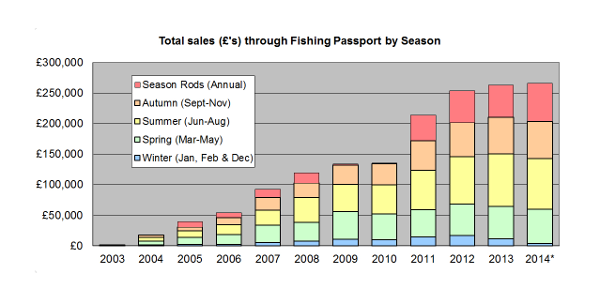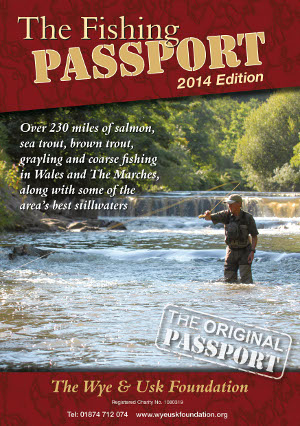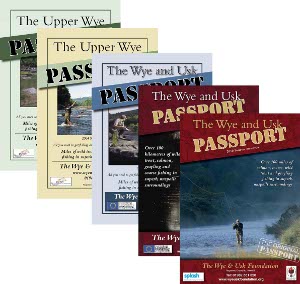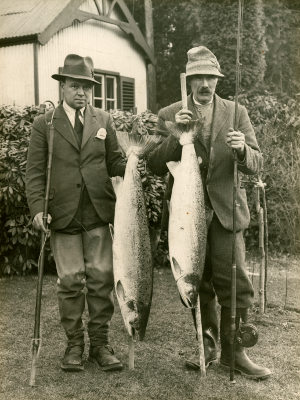The Fishing Passport 
History of the Passport Scheme
The demand to fish the Wye was such that in the mid-20th century it was a case of "Dead Men’s Shoes". Beats were extremely valuable and anglers paid handsomely to fish the better ones. The pressure on catching fish was also high - all methods were used and beats seemed to accommodate many more rods than they do today. In addition, ghillies were employed to ensure catches remained high.
When the salmon runs collapsed in the early '90s, it was sudden and dramatic for all, except the lower beats. Lots of fishing suddenly became available but there was no means of putting anglers in touch with it. In 2003 we contacted all the fishing hotels on the upper Wye and found only one (owned by a keen angler) who was able to accommodate visiting anglers. The economy linked with fishing had all but collapsed along with most of the associated jobs.
In order to meet the requirements of EU funding, it was essential to show that our work and subsequent improvement to fisheries benefitted the rural economy, either with direct employment or by boosting revenue. We needed a scheme that did just this and at the same time enable us to calculate the extent of these benefits. The launch of pHish and some post Foot and Mouth funding (Adfywio) to get visitors back to Powys were the drivers that created the 'Upper Wye Passport' in 2003. The name? Blame the Director!
WHIP, our first project, gave us the opportunity to market restored trout fisheries and by combining neighbouring farmers' ownerships we were able to make beats of a worthwhile size. This gave the farmers some real incentive to look after their tributary. Many also had B&Bs that could be filled by anglers during the less popular months of the year. Our first Roving Voucher (now Wild Stream) scheme was on the Edw, Clettwr and Duhonw. Simplicity was the key factor: fishers bought vouchers, posted them in the beat box and enjoyed a day’s wild trout fishing. Later we added fisheries on the main river, giving rise to the "Booking Office". Then came the Usk, Lugg, Arrow and Monnow; and later reservoirs and still waters.
In 2007, The Rural Enhancement Scheme funded fisheries infrastructure improvements in Herefordshire - paths, huts and bank repairs. The project added another 35 fisheries including, for the first time, coarse fishing on the middle/lower Wye. An online facility was added making out-of-hours bookings possible. A webcam on a gauge heralded a novel way of providing information on water conditions. Now there are nine spread throughout the catchment of them.
In 2003, the first year, 13 main Wye and tributary beats generated a modest £1,845 in fishing sales. Ten years later this was over £250,00 We have over 160 fisheries on board, including some outside the Wye and Usk and some of the area’s top still waters. We calculate the Passport to be worth over £1.3 million annually to the rural economy.

How it works
The Passport is made up of two distinct elements:
Our "Wild Streams" focus on the wild trout fisheries created by our habitat restoration, while our "Booking Office" (telephone and online) has been created to take day, week and season reservations for salmon, trout, grayling & coarse fishing on the larger and more established fisheries.
The Passport offers a huge variety of water for most species of fish. Please click on the image above to request your free copy of the Passport brochure. See "WUF River Reports" section for up to date news and the "Anglers Feedback and Reports" for details of what's being caught and where.
Fishing the Wye & Usk
In the last century, Wye fishing was very salmon orientated. Apart from a handful of the tributaries and some stretches of upper main river, little was mentioned about trout and almost nothing at all about the superb grayling fishing, which continues throughout the autumn and winter. Wye coarse fishing has always been excellent, particularly downstream of Glasbury where the river is host to a range of species: big chub and pike and the highly prized barbel are all common while dace, perch, roach and even bream are also found here.
The Usk, on the other hand, has always been aswell known for its brown trout as its good salmon runs plus the occasional sea trout. The trout fishing is some of the best in the country and if you want a wild fish of over 2lbs from a freestone river, the Usk is the place to come. The last few years have seen resurgence in the upwing fly hatches to go with the summer sedges. There has been a corresponding increase in the average size, now near the 1lb mark. Good catches of trout during the Large Dark olive and March brown hatches in spring are now commonplace, followed by consistent fishing to sedges and Blue winged olives during the summer. In addition to its heavy runs of summer salmon and grilse, the Usk also has a spring run of salmon that peaks in May, an improving sea trout run, and some coarse fishing below Abergavenny.
For more information on salmon, trout, grayling and coarse fishing, please see The Fish.
All the information needed for a visit to the Wye or Usk – accommodation with fishing, a list of other recommended accommodation, pubs, tackle shops, guides/instructors – is given in The Fishing section of our website. When fishing any of the waters in the Passport, anglers must be aware of and abide by Environment Agency bylaws.
We look forward to welcoming you to these two wonderful rivers.
WUF projects that have supported the Passport















